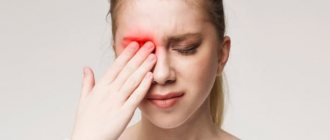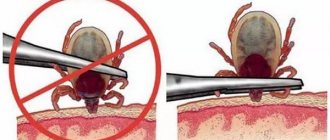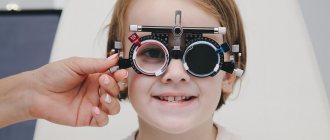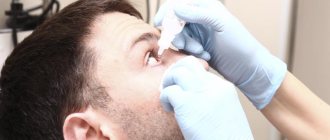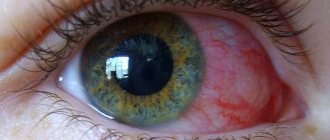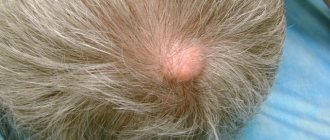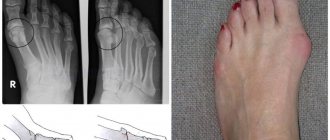Skin diseases are accompanied not only by pain and severe discomfort, but also by the risk of unaesthetic scars or scars appearing on the skin. Therefore, it is extremely important to promptly contact a dermatologist who can diagnose the disease at an early stage and prescribe effective therapy. Our medical center provides the opportunity to receive qualified medical care, as a result of which it is possible to accurately diagnose and eliminate signs of skin damage. One of the most common problems with which patients come in this direction is demodicosis. This is a rather dangerous and problematic pathology, which is almost impossible to cope with on your own.
What is this?
Demodicosis in humans develops as a result of reproduction in the hair follicles, sebaceous glands of the skin and meibomian glands of the iron mite (Demodex). The breeding ground for the development of this parasite is sebum, so its main habitat is the skin of the face and external ears. But with a complicated course and lack of timely treatment, the skin of the chest and back is involved in the pathological process.
It is important to understand that healthy people can also be carriers of such a tick, since it is a representative of normal microflora. According to official statistics, about 60% of people are infected with Demodex, but not everyone develops this parasitic disease. Demodicosis of the body develops with the slightest disturbance of the biocenosis and a drop in immune defense.
How it all happens
Our eyelids are made up of skin, muscle, cartilage, sebaceous glands and meibomian glands. The latter were discovered by the physician Heinrich Mabon, after whom they were named. These glands open through excretory ducts in the intercostal space of the eyelids and secrete a special lipid secretion into the eye cavity. During its release, the cells that produce the secretion are destroyed, which flows towards the edges of the eyelids, under pressure due to the action of the eye muscles during blinking. This secretion is part of the tear and covers the ocular surface with a thin protective film that protects the tear from evaporation.
Demodex, being in the ducts of the meibomian glands, damages the walls of the duct and causes its blockage, thereby causing inflammation and redness of the edges of the eyelids, and dry eyes. Subsequently, so-called muffs and scars form on the edges of the eyelids, and the eyelids thicken. The course of the disease is aggravated by increased sensitivity to tick waste products. The inflammation is accompanied by an allergic reaction of the patient’s body.
Causes of demodicosis
As mentioned above, the main reason for the development of this disease is the active reproduction of the iron mite. There are several possible reasons that can lead to increased activity of these opportunistic microorganisms. These are internal and external factors. The first category includes:
- A significant drop in immune defense and exhaustion of the body caused by poor nutrition, autoimmune pathologies, previous diseases, constant stress, etc.;
- Viral and microbial diseases that occur in chronic forms (hepatitis, tuberculosis, etc.);
- Helminthiases. The vital activity of helminths contributes to the weakening of the immune system;
- Malignant neoplasms. With many types of oncology, the body becomes exhausted, making it more difficult for it to cope with infections;
- Damage to the gastrointestinal tract. There is a proven relationship between the bacterium Helicobacter pylori and demodicosis;
- Other skin diseases. These are seborrheic dermatitis, rosacea, acne, etc. In the presence of inflammatory processes or integrity disorders on the skin, the risk of pathogenic activation of opportunistic flora increases significantly;
- Hormonal imbalance associated with illness or natural condition (for example, pregnancy or breastfeeding).
Skin demodicosis can also develop as a result of exposure to unfavorable external factors. As a rule, they are combined with internal ones, but in some cases (for example, choosing the wrong skincare products) they can be the main etiology. Among them:
- Temperature effect. This parasite multiplies especially actively in warm conditions;
- Unhealthy Lifestyle. This includes poor nutrition, frequent stress and bad habits;
- Use of low-quality cosmetics for care. This is especially true for cosmetics that do not have quality certificates and do not meet legal requirements;
- Poor environmental conditions. High levels of environmental pollution lead to a weakening of the barrier function of the skin.
Supportive treatments
For demodicosis, the use of essential oils is recommended. Oils containing terpenes are deadly to demodex. They have antibacterial, antifungal and anti-inflammatory properties. The best oils to combat this parasite are tea tree oil, clove oil, mint oil, and sage oil. Essential oils should not be applied to the skin in their pure form; they must be properly diluted so as not to cause skin irritation.
Human immunity is also of great importance. A healthy lifestyle, a balanced diet, normal sleep, reducing stress - all this has a positive effect on the immune system and increases the body’s ability to fight various types of infections and parasites. And at the first symptoms of the disease, you should immediately consult a doctor.
Demodectic mange symptoms
Due to the fact that this disease can affect different areas of the skin, the clinical picture differs. In the cutaneous form, the following signs of demodicosis appear:
- Acne of varying severity: from small nodules and ulcers to rosacea;
- A strong tooth that causes discomfort. In most cases, it intensifies in the evening and night;
- Excessive sebum production. It is the greasy environment that is most nutritious for ticks of this genus;
- Red spots that are a symptom of high blood pressure in the blood vessels. This indicates the presence of an inflammatory process in the body;
- Nose enlargement. If you contact a dermatologist late or in the absence of adequate treatment, it is possible to replace the functioning tissue with connective tissue.
Demodicosis of the eyelids and eyes, in turn, manifests itself as follows:
- Clumping of eyelashes. Along their growth line, a thin layer of film is formed that has adhesive properties;
- Redness of the eyelids as a result of the inflammatory process;
- Tired eyes. This symptom occurs due to inflammation and due to the fact that the patient is forced to strain his vision;
- Eyelash loss caused by damage to hair follicles.
Non-drug therapy
Treatment of blepharitis can be carried out not only with the help of medications. Non-drug therapy can also be carried out. So, it is useful to wipe your eyelids with decoctions of calendula or chamomile, or make lotions from green or black tea. To enhance the effect, you should resort to physiotherapy. It is worth taking medications to strengthen the immune system: vitamins and vitamin-mineral complexes. During treatment, it is recommended to avoid spicy, sour and salty foods. It is necessary to seek the help of specialists such as a dermatologist, nutritionist, gastroenterologist and allergist. To cleanse the skin, you can use soap with added tar and rinse it off thoroughly, avoiding contact with the cornea. Additionally, tansy can be used as an antiparasitic agent, a strong decoction of which should be rubbed into the surface of the head. Another effective remedy is propolis. It is necessary to dissolve 5 grams in 100 ml of water and instill this solution into the eyes. This will help relieve irritation, dryness and itching.
Kalanchoe juice will help get rid of skin ulcers: the product should be applied to the edges of the eyelids with a cotton swab. If the crust does not come off the eyelids and pus forms, it is worth treating the area with brilliant green diluted with vegetable oil. Tinctures of ginseng root, eleutherococcus, and echinacea are also indicated for the treatment of blepharitis. An integrated approach will help get rid of this complex eye disease.
Diagnostics
Demodicosis on the face and skin is diagnosed by a dermatologist. If the disease is secondary and has developed against the background of the underlying disease, then doctors of other specialties (gastroenterologist, gynecologist, trichologist, endocrinologist, etc.) may be involved for diagnostic and therapeutic purposes. For diagnosis, first of all, visual inspection is used. The doctor evaluates the condition of the skin, eyes and affected areas of the body. In addition, eye biomicroscopy and laboratory examination methods are practiced. The most informative of them are:
- Slit lamp biomicroscopy of the eye is a non-invasive examination aimed at looking for active inflammation. This is an absolutely painless manipulation that does not require special preparation;
- Eyelash test - involves taking freshly removed eyelashes (4 from each eyelid) for further examination under a microscope. Using this method, it is possible to determine the number of parasites (the presence of more than 1 mite on 2-4 eyelashes is pathogenic). This is also a painless procedure, but before it is carried out it is necessary to abandon decorative and skincare cosmetics for several days;
- Biopsy. This is the most informative diagnostic method, but the most traumatic. Diagnosis is carried out under local anesthesia using a tubular knife or scalpel. The taken biomaterial is fixed in a formaldehyde solution for a day and treated with dyes. This makes it possible to fully visualize the gland and adjacent tissues with the pathogenic mite.
Treatment regimen
A typical treatment regimen for tick-borne blepharitis of the eyelids is based on three basic steps:
- Using warm compresses to warm the glands. The compress should not cause skin burns. To achieve the desired effect, it is enough to hold the compress for 5 minutes 4 times a day.
- Cleansing the eyelids from peeling skin, crusts and other elements of secretion. This can be done using baby shampoo, a few drops of which dissolve in water. A cotton pad is soaked in this solution, and the cleansing process is carried out along the edge of the eyelids.
- Application of antibacterial ointment. The most commonly used is “Tetracycline” or combination formulations with a corticosteroid substance (the latter can only be used in short courses). Ointments against parasites are also used; they will be discussed below.
Classification
Demodicosis (photo can be found below) is classified into 2 main clinical forms - primary and secondary. The first diagnosis is made in the event of a sharp surge in parasitic reproduction and effective treatment with the use of antiparasitic drugs. In most cases, it occurs in people over 40 years of age. The secondary form is diagnosed by identifying concomitant skin lesions and systemic diseases (usually associated with immunodeficiency). In some cases, this diagnosis is found in people taking epidermal growth factor receptor inhibitors and in those who have been exposed to ultraviolet radiation.
Based on the symptoms manifested on the skin, the following types of demodicosis are distinguished:
- Acneiform - the presence of papules and pustules similar to acne;
- Rosacea-like - papules appear due to diffuse erythema;
- Seborrheic - skin rash combined with peeling;
- Ophthalmic - inflammation of the eyelids, accompanied by discomfort in the affected eye.
Results
The disease is caused by skin mites of the Demodex species. This is a fairly common infection. Anyone can get them, regardless of gender or age. The tick itself is not life-threatening; many people are carriers. But with weakened immunity, hormonal, age-related changes in the body, or under the influence of other factors, parasites begin to actively multiply and develop, which can provoke demodicosis. The disease is usually diagnosed using laboratory tests of samples of biological material. The treatment is complex and includes both drug therapy and special procedures to cleanse the skin, relieve inflammation, itching and other symptoms of the disease.
Complications of the disease
Treatment of demodicosis on the face should be carried out exclusively with the assistance of a doctor. Self-medication or ignoring this problem may not only not bring the desired result, but also worsen the course of the pathology. Skin scratching and regular trauma to the skin (due to severe itching and the patient’s desire to remove the rash mechanically) lead to disruption of the barrier function. As a result, the risk of developing a pustular infection significantly increases, which can be diffuse and affect large areas of the body.
In addition, this disease (especially demodicosis on the face in women) leads to psychological problems. As a result of the appearance of visible defects, the patient becomes withdrawn, begins to feel embarrassed about his appearance and stops leading a full-fledged lifestyle (closes himself off from the outside world, stops communicating with people, prefers to be alone). As this problem worsens, the developed complexes can develop into psychoses, neuroses and prolonged depression.
A large number of people with this diagnosis have concomitant pathologies (gastrointestinal tract, endocrine glands, etc.) and chronic infectious foci. Demodicosis damage to the body contributes to the aggravation of these conditions and, accordingly, deterioration of well-being.
How the disease develops
Demodectic mange on the face can develop in several stages. Characteristic symptoms appear as follows:
- The skin on the face turns red. At the same time, the person feels irritation on the skin and heat. At first, the redness is temporary, intensifying in bright sun, after exercise, or drinking hot drinks.
- The redness becomes persistent and permanent. The face is red, especially on the cheeks, chin, nose, and in some cases on the forehead.
- Blood vessels dilate , spider veins appear on the face.
- Papules and pustules develop. These are painful ulcers, acne. They are painful, do not last long, and scars form in their place.
- Rhinophymas appear on the nose - these are compactions, small tumors on the skin. The blood vessels and sebaceous glands become inflamed, the nose enlarges and becomes shapeless. More often, this symptom is characteristic of men with demodicosis on the face.
All this is accompanied by increased sebum secretion or dryness. The skin becomes rough. The person feels burning and itching. There is a tingling sensation on the face and the skin hurts. The face becomes noticeably swollen and swollen due to impaired lymphatic drainage.
Demodicosis of the face is often, but not always, accompanied by demodicosis of the eyelids. Symptoms of eyelid damage include redness, irritation, dryness, and a feeling of a foreign object in the eyes. The eyelids become inflamed and blepharitis appears. Eyelashes stick together and fall out. The eyes are constantly inflamed and tired.
Skin demodicosis
The transmission route is contact or contact-household. Can be transmitted through contaminated clothing, bedding, contaminated hands and more. Demodex is distinguished by its survivability under comfortable conditions that correspond to the daily life of most people. The parasite remains viable at a temperature of 17-20°C for 10 days or more, and in an aquatic environment at a temperature of 12-18°C for 3 days. When water is heated to 50° C, the microorganism dies within one minute, and at low temperatures it dies immediately.
To date, there is no single theory explaining the etiology of the development of the inflammatory process and the active reproduction of mites. But there are several predisposing factors that can provoke these processes:
- Excessive sebum production;
- Improper skin care, abuse of cosmetics (especially low quality);
- Long-term use of external corticosteroids;
- Poor nutrition (abuse of sugar, soda, spicy foods, coffee, alcoholic drinks);
- Concomitant gastrointestinal diseases;
- Reduced immunity;
- Hormonal imbalance, excess weight;
- Psychological problems, frequent stress.
Causes of eyelid disease
Infection with tick-borne blepharitis occurs through contact and household contact. The infection is hidden in bedding (such as feather pillows) or dust. Ticks can also appear from the outside: they are able to live autonomously in humid conditions for up to three days.
The cause of the development of the disease can also be disturbances in the functioning of the nervous or endocrine systems, liver, and gastrointestinal tract. Also, the likelihood of infection increases due to heredity.
Other factors that provoke the occurrence of demodectic blepharitis:
- sunburn or prolonged exposure to high temperatures;
- non-compliance with sanitary standards;
- ophthalmological operations;
- acne-prone skin;
- frequent peelings and facial cleansing, solariums and an overabundance of other cosmetic procedures.
Demodectic mange of the eyelids
Treatment of demodicosis of the eyelids requires a comprehensive approach and qualified medical intervention. Demodectic blepharitis is a chronic disease that occurs with periodic exacerbation and remission. It has the following clinical picture:
- Severe eye fatigue associated with the need to strain to better focus on an object or letters;
- Intense itching in the eyelashes and eyebrows. Often this symptom intensifies with external exposure to heat, in the evening and at night;
- Foreign body sensation, burning and tingling that does not go away after washing or scratching;
- Sticky discharge from the eyes after waking up;
- Accumulation of foamy contents in the eye corners;
- Hyperemia, swelling and thickening of the eyelids (especially at the edges).
- The chronic form of demodectic blepharitis can be complicated by keratoconjunctivitis, keratitis and dry eye syndrome. Therefore, it is strongly recommended to consult with an ophthalmologist at our clinic, who will be able to prescribe preventative and therapeutic therapy aimed at maintaining eye health.
The main symptoms of demodectic blepharitis
With this eye disease, pronounced symptoms are observed. Signs of the disease are usually noticed by the patient himself, but this does not eliminate the need to consult an ophthalmologist
to make a final diagnosis.
The most characteristic symptoms of this disorder include:
- Swelling and itching of the eyes and eyelids;
- Sticky eyelashes;
- A specific plaque, as well as small, but noticeable upon close examination, scales located along the edges of the eyelids and at the roots of the eyelashes.
If you have any of these signs, you should contact a specialist! This is necessary not only to confirm the diagnosis, but also to alleviate your condition.
Demodicosis of the ear
This pathology does not always stop at the face. In advanced cases or in the absence of timely treatment, it spreads to neighboring areas of the body, including the ears. In such a situation, it will not be possible to quickly get rid of demodicosis, especially without medical help. Damage to the auricle is accompanied by the following clinical symptoms:
- Intense itching and irritation of the skin. As a result of constant scratching, bruises and microtraumas appear;
- Hyperemia and swelling of the ear, indicating an inflammatory process;
- The presence of red rashes of varying sizes and quantities;
- Pain upon contact with the skin (often a consequence of a violation of the barrier function of the tissue).
How is demodicosis diagnosed?
Demodectic mange on the face is often confused with rosacea and acne. In fact, tick infestation is very often combined with these diseases. When a person has both demodicosis and acne, the rashes are asymmetrical, there are more of them on the cheeks and closer to the temples. Demodectic mange worsens rosacea; due to mites, redness, itching and peeling become stronger.
To understand exactly what causes redness and discomfort, a diagnosis is necessary. If mites are found in the rashes, we can talk about demodicosis, and their number should be more than 5 individuals per square centimeter of facial skin. If there are fewer of them and there are no clinical symptoms, then in this case the person is considered not sick, but a carrier of the tick. It does not require treatment. To detect mites, the skin flakes and the contents of the sebaceous ducts are examined.
Demodicosis of the head
Ticks of the genus Demodex are representatives of opportunistic microflora of the skin on the body, including the head. They are present in almost all people on the planet. In everyday life, their activities do not cause visible discomfort; they exist in a mutually beneficial relationship with humans, fighting harmful microorganisms. But when the immune defense drops and unfavorable conditions set in, the parasites begin to multiply uncontrollably, as a result of which their numbers increase greatly, and the vital activity of these parasites becomes noticeable. This situation can result from:
- Hormonal imbalance;
- Long-term use of antibacterial and hormonal medications;
- Poor nutrition;
- Abuse of saunas, steam baths and solariums;
- Using low-quality cosmetics to care for skin and hair (since demodicosis needs to be treated comprehensively, our clinic specialists help patients choose the right and safe care products);
- Failure to comply with simple hygiene rules.
Treatment
Treatment for eye demodicosis is long-term, and the disease tends to recur. That is why it is important to follow all the doctor’s recommendations and take care of daily hygiene procedures: caring for the area around the eyes using appropriate cosmetics (disposable moisturizing wipes, emulsions, creams). The goal of treating the disease is not only to reduce the number of demodex colonies, but also to get rid of itching, inflammation, as well as restore the ocular surface and stabilize the tear film.
Hygienic care of the ocular surface and skin of the eyelids is the main focus of therapy. In addition, the specialist prescribes ointments with antibacterial and anti-inflammatory components. Therapy lasts at least 2 months and requires regularity, strict implementation of all recommendations and repeated microscopic examination to assess effectiveness.
Demodicosis treatment
The treatment regimen for demodicosis is a set of measures aimed at eliminating external symptoms and the cause that provoked them. The final stage of therapy is the use of preventive measures that help consolidate the therapeutic result and prevent relapse of the disease. It is important to understand that it is almost impossible to cope with this problem on your own. This problem requires qualified help and long-term drug treatment, since an infected person is dangerous to others. It is a source of infection and can therefore infect other people.
Standard therapy aimed at eliminating demodicosis infection consists of several parts:
- Diet for demodicosis. The patient will need to give up fatty, spicy and smoked foods. It is also recommended to reduce your consumption of sugar, sweets and dairy products. The diet should consist of low-fat fish, vegetables and fruits;
- Local treatment. For this purpose, sulfur ointment is used for demodicosis, creams and sprays that have antibacterial and antiparasitic properties;
- Systemic treatment. It is aimed at normalizing sebum production and eliminating existing imbalances (hormonal or metabolic). To do this, it is possible to involve specialized specialists, prescribe antibiotics in tablet or injection form;
- Symptomatic treatment. It is aimed at improving the patient’s well-being, eliminating active symptoms (inflammation, itching, soreness and redness). For this purpose, a special anti-demodetic mange may be prescribed;
- Physiotherapy. To improve the condition of the skin, electrophoresis, laser therapy and ozone therapy are prescribed.
Since it is practically impossible to cure demodicosis quickly but effectively, the average duration of the treatment course ranges from one to several months. The duration depends on the severity of the pathology and the individual characteristics of the body (in some cases, treatment may take a year or more). The main criterion for cure is a repeat tape test with a negative result.
How to treat demodicosis on the face
To confirm the diagnosis and obtain an effective treatment regimen, you need to consult a dermatologist. All drugs used in the course of treatment must do the following:
- destroy parasites;
- disinfect the skin;
- remove inflammation;
- reduce lard production.
There are various ways to combat demodicosis. Treatment can take up to a year, but usually the treatment time is 2 – 3 months. It consists in applying antiparasitic and anti-inflammatory ointments, creams, and gels to the affected areas of the skin. The most common remedy is sulfur ointment. It kills adult ticks and eggs, disinfects the skin, and promotes its restoration. A wide range of acaricidal drugs are also used. Depending on the degree of damage, they are applied several times a day, and treatment takes from a couple of weeks to several months.
In some cases, topical medications are supplemented with immunostimulating agents to enhance the body's immune response and speed up recovery. If an infection is added to the skin lesions from mites, treatment with antibiotics may be required. This should only be prescribed by a doctor. Itching, burning and tingling are relieved with antihistamines.
In addition to treating the skin, it is important to identify and eliminate the causes that caused demodicosis in humans. If there are problems with the gastrointestinal tract, diet, proper nutrition, and the exclusion of fatty, salty, and sweet foods help. It is also necessary to provide a sufficient amount of water, vitamins, and minerals. Eliminate stressful situations and other circumstances that could cause an exacerbation of demodicosis.
Demodicosis - drugs for treatment
Today, finding effective remedies for demodicosis will not be a problem. The specialists of our medical center select medications in the optimal form on an individual basis, thereby speeding up the healing process. The most popular and effective remedies are described below.
Soap
- Demolan Forte and Stop Demodex demodex.by are especially popular among patients. For demodicosis of the eyelids, the treatment regimen often includes these drugs, as they show excellent results due to the presence in the composition:
- Glycerin - absorbs moisture, holding it on the skin. This helps prevent drying, promotes hydration and improves elasticity;
- Octopirox is an antimicrobial component that inhibits the activity of ticks. It gently exfoliates the top layer of the epidermis, normalizing the process of formation of new cells;
- Propylene glycol - helps normalize microflora, moisturizes the stratum corneum;
- Diazolidinyl urea - provides an antimicrobial effect.
Lotion
Demolan Forte and Stop Demodex lotions are prescribed for constant facial skin care and for cleansing damaged skin areas (even demodicosis on the back) before using the gel. They are often used for eyelid hygiene (for blepharitis), as they deeply cleanse the pores and facilitate the penetration of the active substances of subsequent medications. With their help, it is possible to soften the epidermis and normalize fat metabolism without resorting to tapping the skin. As a result of their regular use, mites are deprived of their nutrient medium, and the tissue is regenerated at an accelerated rate without the formation of scars.
Balm
Therapeutic and prophylactic balm Stop Demodex significantly increases the effectiveness of the main therapy. With its regular use, a visible therapeutic effect is observed after 2-3 days. It has the following properties:
- Anti-inflammatory and bactericidal;
- Moisturizing the skin;
- Promotes rapid tissue regeneration and healing;
- Improves local metabolism;
- Penetrates the cell membrane of the epidermis, replenishes the lack of microelements.
Eye gel
When diagnosing eye demodex, it is strongly recommended to use Demolan Forte and Stop Demodex gels. The presence of peppermint extract in the composition guarantees local anesthesia and inhibition of inflammation. They have a calming and refreshing effect, due to which the patient’s well-being noticeably improves. The presence of metronidazole provides effective antiprotozoal and antibacterial effects, while hyaluronic acid helps improve skin elasticity and firmness. These demodicosis preparations are perfectly absorbed, do not clog pores and do not disrupt cellular metabolism. They accelerate tissue regeneration and prevent the formation of scars.
Cream
An effective cream for demodicosis, Stop Demodex, with constant use, makes it possible to stabilize the normal secretion of the sebaceous glands, restore the skin microflora, eliminate the uncontrolled proliferation of parasites of the Demodex genus and noticeably cleanse the skin from foci of inflammation. It does not contain antibiotics, perfectly nourishes, increases tissue firmness and elasticity, and does not have a comedogenic effect.
Mask
For demodicosis infection, it is strongly recommended to buy a Stop Demodex treatment mask. It contains the active Cutipure complex and white clay, which promotes deep cleansing of pores and reduces the proliferation of pathogenic mites. It has anti-inflammatory, antibacterial and keratolytic effects. Its use allows you to normalize sebum production, tone the skin, improve metabolic processes in cells and accelerate tissue regeneration. Moreover, with its help it is possible to remove toxic molecules.
Shampoo
Using Stop Demodex shampoo for demodicosis of the head, you can significantly reduce itching, eliminate dandruff and stop the active reproduction of parasites. It has a strong anti-inflammatory and regenerating effect, fights mites and helps eliminate the consequences of the disease. Its effect is aimed at preventing ticks from sucking nutrients, disrupting their DNA replication and protein synthesis in the cell. The drug inhibits tissue respiration, which is vital for parasitic life.
Medicines
To prevent tick reproduction, use the following means:
- "Metronidazole" - antimicrobial gel, course of treatment - up to three months;
- “Tetracycline” ointment, “Tobrex” eye drops, “Tsipromed” - antibacterial agents that help prevent infection, the course of treatment for demodicosis is up to two weeks;
- eye drops “Vitabakt”, “Okomistin” - antiseptics that help prevent the appearance of other infections, the course of treatment is from one to two weeks;
- drops “Opatonol”, “Lecrolin” - antihistamines that help get rid of allergic symptoms, course - one week;
- drops "Indocollir", "Diclo-f" - non-steroidal drugs prescribed when non-infectious diseases are added to the infection;
- drops such as “Artificial tears” - used for dry eyes, the course of treatment is up to two months.
Treatment of blepharitis of the eyelids should be carried out simultaneously with treatment of the face. So, to remove waste products of parasites, washing your face with antibacterial soap should be supplemented with a massage. To prevent re-infection, it is recommended:
- use disposable wipes to remove dirt from the face and eyelids;
- iron pillowcases and towels daily;
- regularly clean glasses, razors and other items in contact with the face from contamination;
- exclude cosmetics and get rid of products that have come into contact with parasites.
For a complete recovery, close contact with other people should be avoided.
Prevention
Demodicosis of eyelashes and other parts of the body can be prevented. To do this, it is enough to follow simple preventive rules. This:
- Maintaining personal hygiene (regular showering, thoroughly washing your face, washing your hair and hair);
- Eat a varied, rational and healthy diet (include fish, vegetables and fruits in your diet);
- Increased immune defense;
- Correct selection of decorative and skincare cosmetics;
- Do not use other people's cosmetics and personal hygiene products.
How is demodicosis of the eye transmitted?
Demodectic mange of the eyes can be contracted at home - by sharing hygiene items, towels, bed linen, and cosmetics with the patient.
To prevent re-infection, you need to change your pillowcase and towel (or use paper towels) daily, and throw away contaminated cosmetics.
To treat each eyelid, you must use a separate (new each time) cotton swab.
1 Diagnosis and treatment of demodicosis
2 Diagnosis and treatment of demodicosis
3 Treatment of demodicosis
Demodicosis in children
- In childhood, this pathology rarely develops (due to the low activity of the sebaceous glands), but its course is much more complicated than in adults. As a rule, in children this disease is chronic, and relapses occur in the off-season. The main signs of the problem are:
- Swelling of the eyelids;
- Loss of eyelashes and hair;
- Severe eye fatigue;
- The appearance of spots on the skin;
- Itching, worse at night and on contact with water;
- Decreased appetite, moody behavior, decreased physical activity;
- Pain in the eyes.
The treatment regimen for democosis of the face and other parts of the body in children is practically the same as therapy for adults. It also includes diet, medication and rehabilitation aimed at healing the tissue and preventing scarring. The fundamental difference in the treatment method is only the dosage of medications, which will be lower in childhood.
Preventive measures to prevent demodicosis
During primary infection with this disease, prevention should be aimed at a general increase in immunity.
Maintaining hygiene, alternating visual stress with periods of rest, and regular visits to an ophthalmologist for preventive examinations are of great importance.
If the disease is chronic, prevention should be focused on eliminating self-infection:
- To wipe your eyes, you must use disposable wipes.
- Treat glasses with antiseptic solutions.
- Minimize contact with your face and avoid touching your eyes unnecessarily.
- Treat your face with lotions containing alcohol.
- Disinfect razors.
- After massaging the eyelids, wash your face.
- Change bed linen as often as possible, or before going to bed, place a disposable cloth napkin on the pillow, or iron the linen with a hot iron.
All cosmetics, tools for applying them, and lenses must be disinfected or disposed of. If these rules are followed, the cured pathology will not arise again and will not spread to other areas of the skin.
Demodicosis in men
Demodectic mange infection occurs in both women and men, regardless of age or race. It has no distinctive features in its course, prognosis, symptoms and causes of development. Therapy is prescribed on an individual basis, but is usually the same for all genders. Differences may only relate to the dosage of medications.
According to statistics, women suffer from demodicosis 4 times more often than men. There is no scientific explanation for this information, but many are inclined to the hormonal theory. It is based on the fact that due to a regular surge of hormones (menstrual cycle, pregnancy), female representatives are more prone to stress and immunodeficiency states. The clinical picture of the disease is standard and includes:
- Skin rash of varying severity;
- Itching, pain and discomfort in the damaged area;
- Increased sebum production;
- Pain in the eyes, sensation of a foreign body.
The treatment regimen for demodicosis for women is standard. It consists of a diet, long-term medication and the use of special care products (oils, lotions, creams, etc.) to prevent relapse and consolidate the therapeutic result.
Treatment of demodectic blepharitis
The course of treatment is drawn up by an ophthalmologist. Only a specialist can correctly select and combine medications; self-medication is unacceptable!
Drug therapy
The doctor selects medications based on several factors, including the degree of the disease and the patient’s age. The following types of drugs may be prescribed to treat blepharitis:
- Antimicrobial agents, mainly in the form of ointments;
- Antiseptics (selected by a doctor);
- Tear replacement therapy - the patient may experience discomfort in the eyes in addition to itching. To eliminate them, the specialist prescribes lipid-containing moisturizing preparations of high or medium viscosity;
- Anti-inflammatory drugs, usually hormonal ointments with corticosteroids;
- Antibiotics in drops or ointments. Antibiotic therapy is prescribed in rare cases when inflammation of the eyelids has reached a high degree of development and is no longer amenable to other types of treatment.
Non-drug therapy
At the discretion of the specialist, additional non-drug therapeutic procedures may be prescribed, including eyelid massage. As a rule, eyelid massage is accompanied by special warm compresses. The patient can perform these procedures independently, at home.
After compresses and eyelid massage, the patient can treat certain areas of the skin with an antiseptic and antiparasitic agent.
As an additional effect on demodicosis, magnetic or ozone therapy can be prescribed, which is carried out in the clinic.
How long does it take to treat demodicosis?
Although the first signs of improvement, as a rule, occur within a few days from the start of therapy, treatment lasts quite a long time - from two weeks to a month.
Treatment of demodicosis can last up to a month
If the patient follows all the doctor’s instructions, but the condition of the eyes and eyelids does not improve within a week, it is necessary to contact an ophthalmologist again to select more effective therapy.
Questions and answers on the disease
Can a sick person infect others?
Yes, you can become infected with demodicosis through contact and household contact. Kissing, hugging, contact with contaminated things of a patient (towel, bed linen, clothes and much more) can be dangerous for a healthy person. But this does not guarantee the manifestation of symptoms of the disease. Ticks of the genus Demodex are representatives of the opportunistic microflora of the skin. They are found in almost all people, but most of them are simply carriers. For the development of a pathological process, the presence of certain factors is necessary (for example, reduced immune defense against the background of an active or past disease).
Can you get infected from animals?
Animals, like humans, suffer from the activity of Demodex mites. But pathogens come in different types - and each of them survives exclusively in the body of its host. When exposed to other conditions, the parasite immediately dies. Therefore, it is impossible to become infected with demodicosis from a pet or wild animal.
Manifestations of Demodex
Demodex is mainly detected in the eyelashes and on the skin of the lower eyelids, less often on the upper eyelid.
Carriage has been identified in all races and nationalities; there is no direct connection between a person’s gender and the disease, however, according to some authors, men are more prone to the disease (about 59%).
Despite the fact that the very presence of a tick on the human body was discovered more than 170 years ago, scientists do not agree on its harmful effects. Some scientific studies classify it as a symbiont (that is, living on the human body, but not causing harm), others recognize its harmful effects, subject to the influence of complexes of unfavorable factors on the human body.
So why is Demodex dangerous and why does a person begin to experience severe discomfort when in close contact with this small mite? In our article we will talk about the influence of this parasite from the point of view of ophthalmology, but since the pathology is closely related to damage to the skin of the face and cervical area, observation by a dermatologist is often required.
